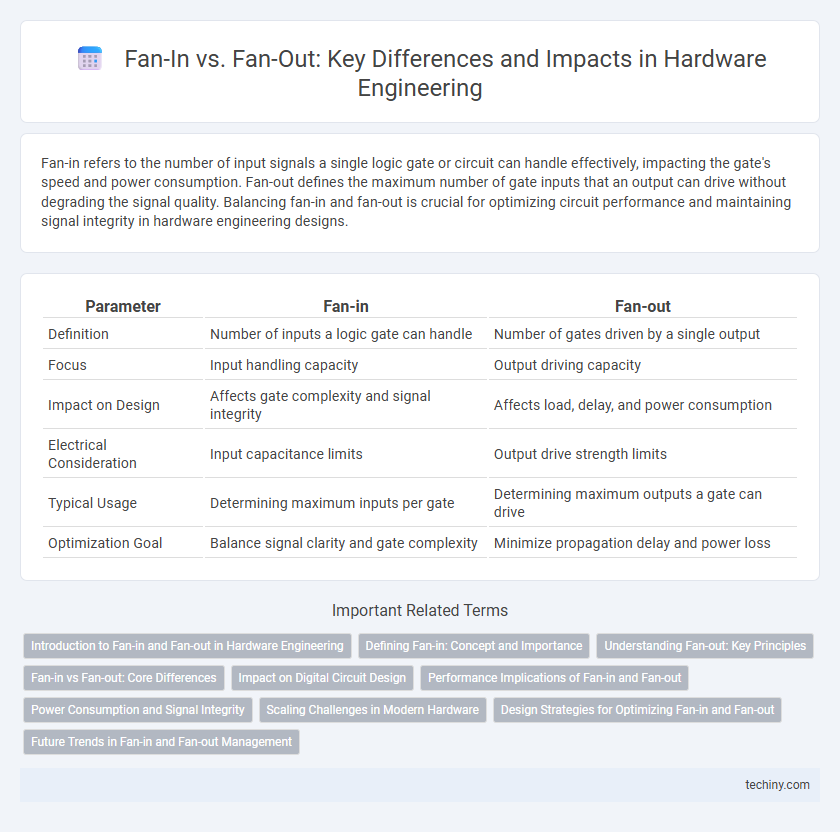Fan-in refers to the number of input signals a single logic gate or circuit can handle effectively, impacting the gate's speed and power consumption. Fan-out defines the maximum number of gate inputs that an output can drive without degrading the signal quality. Balancing fan-in and fan-out is crucial for optimizing circuit performance and maintaining signal integrity in hardware engineering designs.
Table of Comparison
| Parameter | Fan-in | Fan-out |
|---|---|---|
| Definition | Number of inputs a logic gate can handle | Number of gates driven by a single output |
| Focus | Input handling capacity | Output driving capacity |
| Impact on Design | Affects gate complexity and signal integrity | Affects load, delay, and power consumption |
| Electrical Consideration | Input capacitance limits | Output drive strength limits |
| Typical Usage | Determining maximum inputs per gate | Determining maximum outputs a gate can drive |
| Optimization Goal | Balance signal clarity and gate complexity | Minimize propagation delay and power loss |
Introduction to Fan-in and Fan-out in Hardware Engineering
Fan-in in hardware engineering refers to the number of input signals a logic gate can handle without performance degradation, directly affecting circuit complexity and speed. Fan-out measures how many gate inputs a single output can drive while maintaining signal integrity, impacting power consumption and timing. Optimizing fan-in and fan-out is crucial for designing efficient digital circuits with reliable functionality.
Defining Fan-in: Concept and Importance
Fan-in refers to the maximum number of input signals or connections that a single logic gate or device can effectively handle without performance degradation. In hardware engineering, defining fan-in is crucial as it directly impacts circuit complexity, signal integrity, and timing characteristics. High fan-in gates can lead to increased propagation delay and power consumption, making an accurate understanding of fan-in essential for optimized digital circuit design.
Understanding Fan-out: Key Principles
Fan-out in hardware engineering defines the maximum number of inputs that a single logic gate output can drive without signal degradation, directly impacting circuit reliability and speed. Understanding fan-out involves analyzing the gate's drive capability, input capacitance of subsequent gates, and ensuring that the load does not exceed the predefined threshold to maintain signal integrity. Proper fan-out management enhances system performance by minimizing delay, reducing power consumption, and preventing logic errors in complex digital circuits.
Fan-in vs Fan-out: Core Differences
Fan-in refers to the number of input signals a single logic gate or circuit can handle, while fan-out denotes the maximum number of output loads driven by a single output without signal degradation. The core difference lies in fan-in measuring input capacity, which influences logic gate complexity and delay, whereas fan-out impacts output drive strength and the overall signal integrity in hardware designs. Managing optimal fan-in and fan-out values is critical for ensuring efficient circuit performance and minimizing timing issues in integrated circuits.
Impact on Digital Circuit Design
Fan-in refers to the number of input signals a digital logic gate can handle, directly affecting the gate's speed and power consumption due to increased loading and capacitance. High fan-in gates tend to slow down circuit performance and consume more power, while limiting fan-in improves signal integrity and reduces propagation delay. Fan-out, the number of gate inputs driven by a single output, impacts the driving capability and signal strength; controlling fan-out prevents signal degradation and ensures reliable timing in complex digital circuit designs.
Performance Implications of Fan-in and Fan-out
High fan-in in hardware designs can lead to increased gate delay and signal integrity issues, negatively impacting overall circuit performance. Conversely, high fan-out increases the load on outputs, causing slower switching speeds and higher power consumption. Balancing fan-in and fan-out is critical for optimizing timing, reducing propagation delay, and ensuring reliable, high-performance hardware operation.
Power Consumption and Signal Integrity
Fan-in and fan-out directly impact power consumption and signal integrity in hardware engineering, where higher fan-in increases the capacitive load on inputs, leading to greater power dissipation and slower signal transitions. Larger fan-out causes an output to drive multiple inputs, increasing dynamic power consumption due to higher capacitive loading and risking signal degradation through noise and timing delays. Optimizing fan-in and fan-out balances power efficiency and maintains signal integrity, essential for reliable integrated circuit performance.
Scaling Challenges in Modern Hardware
Fan-in and fan-out are critical parameters influencing the scaling challenges in modern hardware design, where increased fan-in complicates signal integrity and timing due to larger capacitive loads on input nodes. High fan-out creates significant issues with propagation delay and power consumption as driving a large number of gates requires stronger buffers and optimized interconnects. Advanced hardware engineering solutions leverage hierarchical buffering and signal repeaters to mitigate scaling limitations while maintaining performance in increasingly dense integrated circuits.
Design Strategies for Optimizing Fan-in and Fan-out
Optimizing fan-in and fan-out in hardware engineering requires balancing signal integrity and timing constraints to enhance circuit performance and reliability. Employ design strategies such as hierarchical buffering and controlled impedance routing to minimize delays and prevent signal degradation in high fan-out scenarios. Employing gate sizing and load balancing techniques ensures efficient signal propagation while reducing power consumption and noise in circuits with high fan-in complexity.
Future Trends in Fan-in and Fan-out Management
Future trends in fan-in and fan-out management emphasize the integration of advanced machine learning algorithms to optimize signal integrity and reduce latency in complex hardware systems. Innovations in materials science, such as the use of graphene and silicon carbide, aim to enhance thermal management and electrical performance, enabling higher fan-in and fan-out densities for next-generation processors. Emerging design automation tools leverage real-time data analytics to dynamically adjust fan-in and fan-out parameters, improving scalability and power efficiency in heterogeneous computing environments.
Fan-in vs Fan-out Infographic

 techiny.com
techiny.com